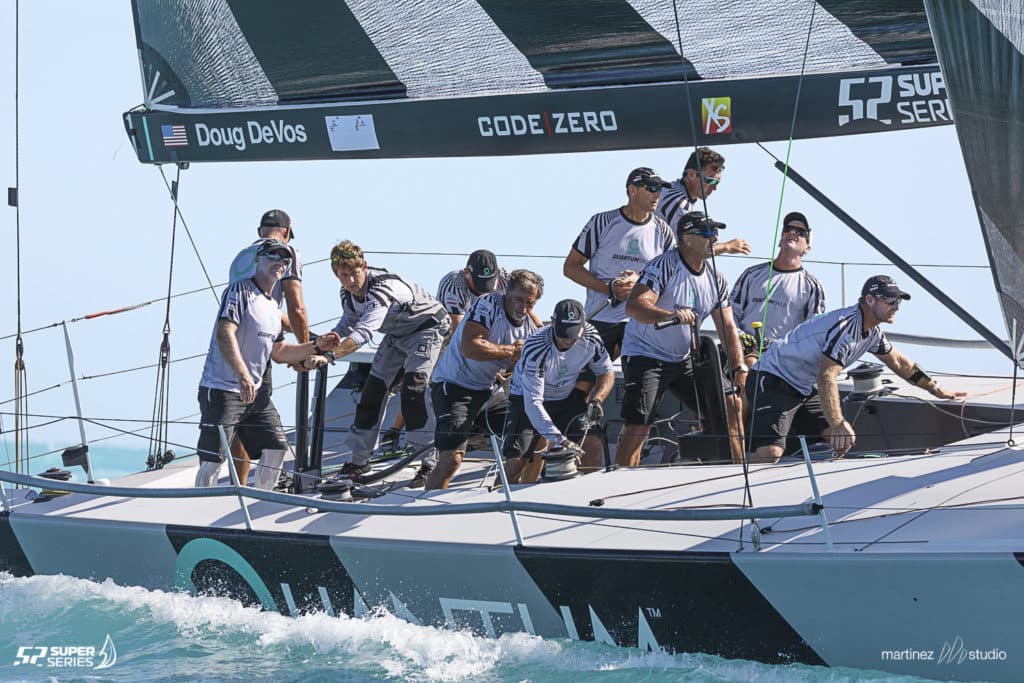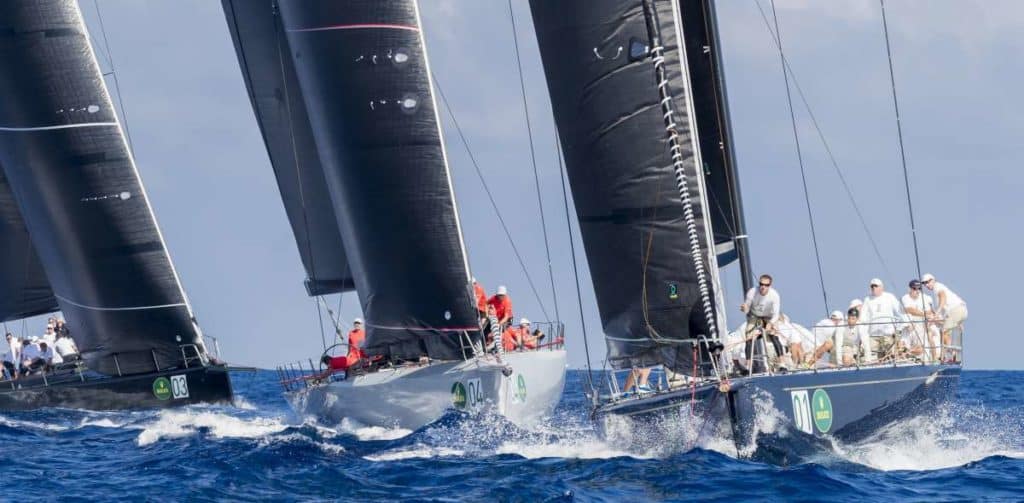
It doesn’t matter which type of boat you race, because success is all about dealing with the details. It’s just a sailboat, with a jib and a mainsail and a spinnaker. Sure, we make it more complicated than that, but at the end of the day, everything is what British cycling coach David Brailsford calls an “aggregation of marginal gains.” In 2008, Brailsford led the British team to an unprecedented eight gold medals and said at the time, “If you broke down everything you could think of about what goes into riding a bike, and then improved it by 1 percent, you [would] get a significant increase when you put [it] all together.”
Sailing is no different. Everybody knows how to sail upwind and downwind, but it’s the aggregation of thousands of tiny gains — which, individually, wouldn’t make a difference in a race — that collectively make a huge difference. In one-design sailing, the difference is more pronounced: If you’re 0.1 percent faster, you’re almost guaranteed to win 80 percent of the races. If you’re 1 percent faster, it’s game over.
At the grand-prix level, the focus on that 1 percent is intense. With the Maxi 72 Bella Mente and TP52 Quantum Racing, which I work with, we end up with a million pieces of data at the end of each day, as well as input from the sailors on board. That information is spread over almost a dozen different charts, one of which has 20,000 lines of data with more than 60 headings across the top for everything from boatspeed to pitch acceleration rates. One of my jobs is to use daily performance-analysis data and the sailors’ testimony to verify performance on the water. We can start to repeat fast settings if we know when we were fast or slow and why. The ability to do that is paramount to consistent performance.
Data does not change what I do as a coach, however. I might still say, “The main is a little too twisted there,” but you try and tell that to guys who’ve won multiple America’s Cups and sail at incredibly high levels, and they want proof. You can’t give them just an observation or a subjective view. The coach’s job is to speed the learning process on board the boat; verify good settings, modes and shapes; and help the sailors repeat those variables day to day.
Our base-line material — the big-picture stuff — comes from KND Sailing Performance, based in Spain. I mine the data we collect to detect the little speed wobbles — why the team is slow for five minutes or fast for five. For example, we’d been sailing a very good coastal race in Porto Cervo at the Rolex Maxi Worlds in 2015. The breeze was in the 5-knot range, but there was quite a big sea state because the wind had been blowing 20 knots all night. We had a performance issue on starboard tack, relative to the other 72s. In fact, we went from being a boatlength behind to being three minutes behind. The data on rudder angle was the key. It showed that we were running negative rudder-angle numbers on starboard tack, which meant we were carrying a bit of lee helm. For optimum VMG, we like to have between 2 and 4 degrees of rudder angle, depending on our leeway value. Our worst VMGs are when we have lee helm, which was what was happening on starboard tack. In fact, the charts showed that our average rudder angle on starboard tack was -1.25 degrees. Why was this happening?
We turned to the sail data and saw that our traveler was a degree or two to windward. It could have been further up, and that might have developed some positive helm. The data also showed we were sheeted relatively hard. In fact, we were at 7 degrees’ twist to center at the top draft stripe. We then compared all of that with our port-tack data. It came down to sea state. The lee helm was not from the boat; it was from the wave action on the side of the boat. Lee helm developed as the boat basically fell off the wave and rolled to windward. We concluded that we probably should have done a number of things — put the traveler up, weight forward, weight to leeward — to counteract the amount of lee helm we were getting. It was a way to see why we were not as fast as the other boats. We had a very similar race at the Rolex Maxi Worlds in 2016, with side-on leftover swell; we took our lessons from 2015 and it made all the difference.

We also track the percentage of draft, camber and twist on each tack, at each moment in the race. This is done with a series of cameras on the boat. They look up at the sails, and software recognizes the three differently colored draft stripes — red, green and orange, from the bottom up. They’re big, so the cameras can easily pick them up. Most raceboats, from the J/70 on up, use target boatspeeds. We, on the other hand, have target sail shapes for given windspeeds. The trimmers use these targets to get the sail in the shape ballpark and then refine from there. Thus, there is much discussion among trimmers about target sail shapes, and we use the data in postrace analysis to confirm good shapes for the conditions that we can repeat in a future race.
A discussion between the coach, sail designer, trimmer and runner trimmer may start with an observation such as “It would be great to get our bottom stripe at 7 percent to be able to get the midstripe at 9.5 percent.”
We’d love to run the bottom at 8 percent and the middle at 8.5 percent, but that’s impossible based on the compromise for headstay tension and jib shape that would be needed to achieve the mast bend to get us to the numbers. The camera data allows us to quantify all of this and pay attention to the 1 percent of difference we’re after at the bottom stripe. Small percentage changes, big gain possibilities.
It’s no different on smaller boats. The J/70 and Melges 20 teams I’ve coached were also trying to improve the 1 percent in all areas, but because those boats were one-designs, our goal was to keep it simple. We used the Velocitek to log data analysis so we could verify our two-boat testing sessions. It’s always great to have metrics on who really was faster in an individual speed run. We also thought about the low-hanging fruit. For example, we gained about three races of sail life because, after each race, we furled the jib, dropped the mainsail and motored in under outboard. We also dropped the jib and rolled it every night at the dock so the leech wouldn’t get a reflex curl from being left furled overnight. And we marked the boat properly, ensuring all of the trim marks were correct and matching, so the boat was set up identically, side to side. That allowed us to replicate rig settings and sail trim, tack to tack, race to race, and day to day.
If you start breaking it down, you’ll see it’s all about trying to make little gains on everything. Everybody thinks a winning campaign requires some magic pixie dust, “something special.” But at the end of the day, it comes down to hard work from a group that keeps moving forward in several different areas. For me, that’s what winning is: tiny, incremental gains. Whenever you try to make the big gain, there’s always an opposite decrease in performance in another area. There are few magic moments. I suppose foiling in the AC boats might be the exception, but for the rest of the world, we don’t have that type of quantum leap. We’re further down the evolutionary ladder.
Watch Terry Hutchinson sail Quantum Racing and Bella Mente, and you’ll see that he drills the idea of attention to detail, as well as mental toughness, into everybody — attention to detail in the processes we use, in how the boat is prepared, and in how the sails are built. All of the top sailors have this focus.
Keep track of the details — the 1 percent — and then structure everything so you can repeat it. All these processes, details and talent build an unstoppable juggernaut based on the foundation of a team. We do it correctly; we put structure into every detail, from the starts to the design, meals, people and so on. It’s a whole team buying in to the process of incremental improvement. Each piece of it is relatively regimented: You build this juggernaut, but if there’s any detail missing — if you have a wheel not running true — you’re going to lose. For me, that’s the big thing. Keep the juggernaut on the straight and narrow, and make sure it’s rolling.
When most people see professionals sailing, they see the product racing on the water, but it’s like an iceberg — the sailing is only 10 percent of the effort. An equal part of a successful team is maintaining the boats onshore; improving the design; packing the boats; packing the sails; modifying sails; and examining winches, hydraulics, rope, paint, sails, structures, etc. — in other words, owning the details.
James Lyne coached teams to four world championships — in the Farr 40, Melges 32, TP52 and Maxi 72 — in 2016.









